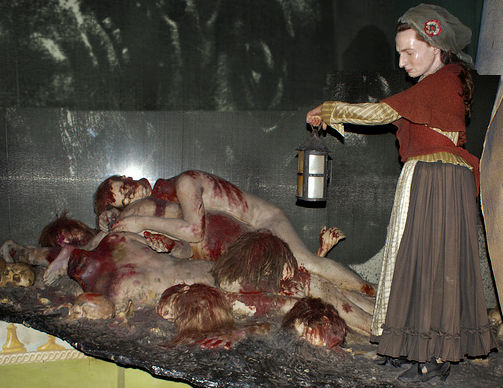The Essence of the Revolution
Having rapidly described the crisis of the Christian West, we will now analyze it.
1. The Revolution Par Excellence
As already stated, this critical process we have been considering is a revolution.
A. Meaning of the Word Revolution
By Revolution we mean a movement that aims to destroy a legitimate power or order and replace it with an illegitimate power or state of things. (We have purposely not said “order of things.”)

Marie Grosholtz (Madame Tussaud) 1761-1850. A scene from the Chamber of Horrors in London of Madame Tussaud searching for the guillotined head of Marie Antoinette at Madeleine Cemetery, October 16, 1795. In Paris of 1770, Madame Tussaud learnt to model wax likenesses under the tutelage of her mentor, Dr Philippe Curtius. At the age of 17, she became an art tutor to King Louis XVI’s sister at the Palace Of Versailles. During the French Revolution, Marie was commanded to visit the mass graves to collect the severed heads of notable Royalist and Revolutionary victims of the guillotine so as to make new death masks. She even did Robespierre own death mask after he was a victim of the guillotine. The rebels used their death masks as trophies and paraded them through the city. She survived the Revolution and brought her exhibition to England in 1802. Photo by mariosp & bruciestokes.
B. Bloody and Unbloody Revolution
In this sense, strictly speaking, a revolution may be bloodless. The one we are considering developed and continues to develop by all kinds of means. Some of these are bloody, others are not. For instance, this century’s two world wars, from the standpoint of their deepest consequences, are chapters of it, and among the bloodiest. On the other hand, the increasingly socialist legislation in all or almost all countries today is a most important and bloodless progress of the Revolution.

Fidel Castro and former Brazilian President Luiz Inácio Lula da Silva.
C. The Amplitude of the Revolution
Although the Revolution has often overthrown legitimate authorities and replaced them with rulers lacking any title of legitimacy, it would be a mistake to think this is all there is to the Revolution. Its chief objective is not the destruction of certain rights of persons or families. It desires far more than that. It wants to destroy a whole legitimate order of things and replace it with an illegitimate situation. And “order of things” does not say it all. It is a vision of the universe and a way of being of man that the Revolution seeks to abolish with the intention of replacing them with radically contrary counterparts.
D. The Revolution Par Excellence
In this sense, one understands that this is not just a revolution; it is the Revolution.
Next
Plinio Corrêa de Oliveira, Revolution and Counter-Revolution (York, Penn.: The American Society for the Defense of Tradition, Family, and Property, 1993), Part I, Ch. VII, Pgs. 40 & 41.






